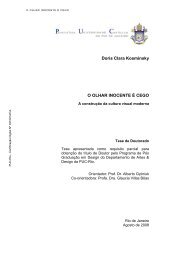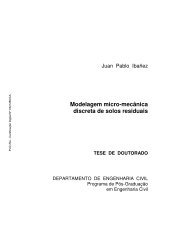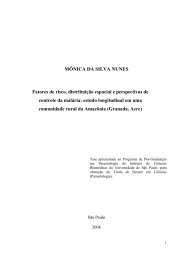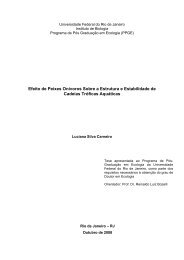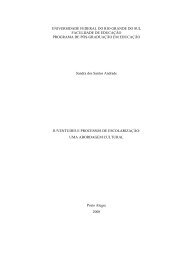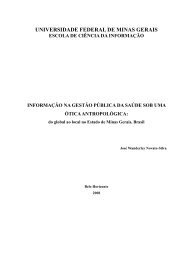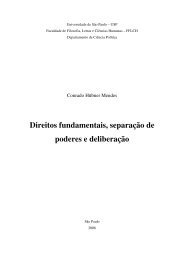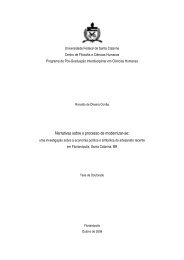You also want an ePaper? Increase the reach of your titles
YUMPU automatically turns print PDFs into web optimized ePapers that Google loves.
468 R.S. Car<strong>do</strong>so et al. / Molecular Immunology 43 (2006) 464–472Table 1Frequency (%) of apoptotic and necrotic cells in 4 Gy irradiated and controlFTOCsApoptosisNecrosisStagingStagingControl 15 1.2 ± 0.5 15 4.1 ± 1.516 1.0 ± 0.5 16 3.0 ± 1.017 3.2 ± 1.0 17 5.2 ± 1.520 2.0 ± 1.0 20 2.7 ± 1.0Irradiated 15 1.8 ± 1.0 15 4.1 ± 0.516 1.9 ± 1.0 16 4.2 ± 1.017 3.0 ± 0.5 17 2.3 ± 0.520 2.1 ± 1.0 20 5.8 ± 1.5Mean and standard deviation of three independent determinations. Data analyzedby t-test (P < 0.05).Staging corresponds to development of fetal thymus in culture; 15FTOC = 13 day gestation thymus plus two days in FTOC.<strong>gene</strong>s implicated in cell cycle control, DNA repair, T-celldifferentiation and V(D)J recombination were selected fordiscussion. The complete color heat-map indicating thesix <strong>gene</strong> clusters is available online at (www.rge.fmrp.up.br/passos/FTOCcluster/9216).Among the <strong>gene</strong>s differentially expressed, we selected 42to discuss from six clusters whose functions are associatedwith cell cycle control, transcription factors, immune regulation,T-cell V(D)J recombination and DNA repair (Table 2).4. Discussion4.1. T-cell receptor and TRBV8.1 rearrangement occursin vitro in FTOCThe IL-7 is a cofactor associated with modulation ofV(D)J recombination of TCR <strong>gene</strong>s (Muegge et al., 1993;Sollof et al., 1997).In this study, we described for the first time the occurrenceof TRBV8.1-BD2.1 V(D)J recombination in vitro in FTOC.The onset of TRBV8.1-BD2.1 V(D)J recombination invitro mimicked the thymus gestation in vivo, demonstratingthat this model system is similar to the in vivo development ofFig. 2. Clustering RNA (cDNA) samples and 9216 <strong>gene</strong>s of each developmentalphase of control and gamma-irradiated FTOCs. The hierarchicalclustering algorithm compared means of the different <strong>gene</strong>s and RNA(cDNA) samples whose standard deviations did not overlapped computingthe dendrogram that assembled all elements into a tree. Complete colorheat-map indicating the repressed, induced and unmodulated <strong>gene</strong>s amongall situation studied is available online at (www.rge.fmrp.usp.br/passos/FTOC/cluster9216).the thymus in inbred mouse strains, as previously describedby our group (Espanhol et al., 2003; Mace<strong>do</strong> et al., 1999).On the basis of a variety of criteria, FTOC reproducesthe normal thymic development; however, the results can beinfluenced by the length of culture, and mouse strain and age(DeLuca et al., 1995).In addition, it was shown that there are differences intemporal rearrangements at the TRBV locus, including theTRBV8.1 segment, among BALB-c, C57Bl/6 and CBA/Jinbred mouse strains, probably due to the different <strong>gene</strong>ticbackgrounds of the different strains (Espanhol et al., 2003;Mace<strong>do</strong> et al., 1999; Junta and Passos, 1998).For this reason, the fetuses used in this study were obtainedwithin the age range of 13–15 days of gestation pc, whichpermitted comparisons with the data obtained in vivo withthe BALB-c strain.4.2. Hierarchical clusteringThe expression patterns disclosed several clusters of coexpressed<strong>gene</strong>s, six of which (clusters 1–6) were selectedfor discussion on the basis of the biological functions of themost relevant <strong>gene</strong>s investigated in this study.Cluster 1 (correlation = 0.81) harbors <strong>gene</strong>s which wereinduced in irradiated cultures. This cluster displayed <strong>gene</strong>sinvolved in cell cycle/cell division and DNA repair. Amongthem, we pinpointed MYB (myeloblastosis onco<strong>gene</strong>, accessionno. NM010848, chromosome 10), which has a rolein transcriptional activation and in the control of proliferationand differentiation of hematopoietic progenitor cells,and Kirsten rat sarcoma onco<strong>gene</strong> 2 (KRAS2, accession no.NM021284, chromosome 6). This onco<strong>gene</strong> belongs to thesmall GTPase superfamily (ras family), whose proteins bindto GDP/GTP and possess intrinsic GTPase activity. Its biologicalfunction is associated with control of the cell cycle.The induction of these onco<strong>gene</strong>s suggests triggering cell divisionby irradiation in FTOCs.Interestingly, the cell division cycle 42 homolog S. cerevisiae<strong>gene</strong> (CDC42, accession no. NM009861, chromosome4) which plays a role in GTPase-mediated signal transductionand participates in cytokinesis, presented an expressionprofile similar to that of the KRAS2 onco<strong>gene</strong>, suggestingthat GTPase activity seems to be required after exposure toionizing radiation.The X-ray repair complementing defective repair in Chinesehamster cells 5 <strong>gene</strong> (Ku80) (XRCC5, accession no.NM009533, chromosome 1) participates in the mechanismof DNA <strong>do</strong>uble-strand break repair (DSB repair) via NHEJ.The induction of the XRCC5 <strong>gene</strong> suggests that NHEJ mayconstitute an important process of DNA repair in irradiatedFTOCs.Cluster 2 (correlation = 0.71) encompasses <strong>gene</strong>s involvedin the regulation of transcription in T-cells suchas signal transducer and activator of transcription 4 <strong>gene</strong>(STAT4, accession no. NM011487, chromosome 1), whoseactivities are associated with a transcription factor and



